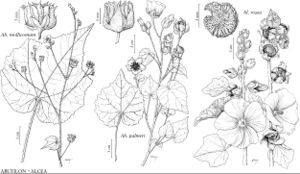Alcea
Sp. Pl. 2: 687. 1753.
Gen. Pl. ed. 5, 307. 1754.
| Taxon | Illustrator ⠉ | |
|---|---|---|
 | Abutilon mollicomum Abutilon palmeri Alcea rosea | Linny Heagy Linny Heagy Linny Heagy |
Herbs, [annual], biennial or perennial, stellate-hairy to pilose or hirsute or glabrous, [sometimes with some long, simple hairs, sometimes glabrate]. Stems erect, usually simple. Leaves: stipules persistent or caducous, ovate [unlobed] or 2–4-fid, sparsely to densely stellate-pilose; blade orbiculate, angled, weakly lobed or deeply palmately parted, base cordate, cuneate, or truncate, margins crenate-serrate, apex acute to obtuse. Inflorescences terminal and/or axillary, usually unbranched, racemes, often with 1–5-flowered axillary fascicles, elongate, flowers axillary, solitary or fascicled; involucellar bractlets persistent, attached to apex of pedicel, connate basally, 6–7 [–9] -parted, stellate-hairy. Flowers: calyx usually accrescent, not inflated, lobes slightly or conspicuously striate, lanceolate, margins entire, apex obtuse to acuminate, densely stellate-pilose-hairy; corolla rotate, white, pink, red, purple, or yellow, darker or paler basally, base densely white-pilose-hairy; staminal column exserted, 5-angled, anthers crowded, pale-yellow, glabrous; ovary [15–] 20–40-carpellate; ovules 1 per carpel; style [15–] 20–40-branched (equaling number of locules); stigmas decurrent, filiform. Fruits schizocarps, erect, not inflated, disc-shaped, dry, central axis equaling or shorter than mericarps, indehiscent; mericarps [15–] 20–40, 2-celled (proximal cell 1-seeded, distal cell sterile), laterally compressed and reniform-circular with prominent ventral notch, smooth to wrinkled, hairy [glabrous]. Seeds 1 per mericarp, brown, reniform, glabrous or minutely hairy. x = 21 [n = 13, 21].
Distribution
Introduced; s Europe, Asia (Mediterranean region to c Asia)
Discussion
A few species of Alcea are widely cultivated and both species in the flora area are escapes from cultivation. Various authors have treated some of these taxa within Althaea, but this disagrees with Linnaeus’s concepts of the two genera as quite distinct. The primary difference is that Alcea has a two-chambered mericarp (the upper chamber being empty and vestigial) and yellowish anthers, and Althaea has a one-chambered mericarp and purple or brownish-purple anthers. Current treatments consistently accept the two genera as distinct; see M. E. Uzunhisarcikii and M. Vural (2012) for a discussion of the two genera and their circumscriptions.
Alcea biennis Winterl occasionally is planted and rarely is found as an escape. It differs from the two species treated here by its white to pink corolla with a pale yellow to greenish center and by its generally more deeply lobed petals that are usually more separated and less overlapping. Its involucel is more than one-half as long as the calyx, sometimes equal in length, the sepals are conspicuously striate, the pedicel is 1–25 mm long, and the mericarps are conspicuously winged; its leaves are inconspicuously lobed or merely angled.
Species ca. 70 (2 in the flora).
Selected References
None.
Lower Taxa
Key
| 1 | Leaf blades angled or shallowly lobed or rarely more deeply; flowers usually white, pink, red, or purple, rarely yellow, not drying greenish; involucellar bractlets 1/2+ calyx length. | Alcea rosea |
| 1 | Leaf blades lobed usually halfway or more to midrib, often figlike; flowers pale yellow, usually drying greenish; involucellar bractlets usually 1/2–2/3 calyx length. | Alcea rugosa |